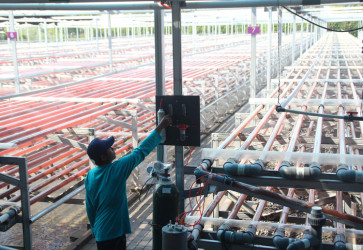National exam scores take a tumble
Results of the 2018 Junior High School National Exam revealed that scores in all four subjects tested had significantly dropped, with students performing the worst in math and natural science
Change text size
Gift Premium Articles
to Anyone

R
esults of the 2018 Junior High School National Exam revealed that scores in all four subjects tested had significantly dropped, with students performing the worst in math and natural science.
The average score for math dropped by almost 7 points from 50.31 in 2017 to 43.32 in 2018, while the average natural science score decreased 4.75 points from 52.18 in 2017 to 47.43.
National Exam results are not a determinant factor for high school registration.
However, when the results were announced on Monday, the Education and Culture Ministry’s head of research and development, Totok Suprayitno, insisted the scores reflected an improvement in the quality of the exam.
“It is actually an improvement rather than a decrease [in quality],” Totok said on Monday.
He went on to say that the lower scores were likely due to the fact that the exams were computer-based, suggesting that this new system had therefore uncovered flaws in the system that previously went undetected.
Schools had shifted from paper-based exams to minimize the risk of question sheets being leaked to the public and cheating among students.
Last year, schools that scored low in the integrity index achieved an average exam score of 73.05. After adopting the computer-based exam this year, however, their average score dropped to 45.04.
By contrast, the average exam score of schools that have been using computers to conduct their exams for the past two years increased from 51.71 in 2017 to 52.03 in 2018.
“The National Exam is not only a tool to map out [learning outcomes], but also a means to diagnose problems [within the learning system] and recommend the best solutions,” Totok said.
Therefore, the previous paper-based national exams, which Totok called “fake and foul”, were not a reliable instrument to measure the quality of the country’s education system.
Responding to students’ complaints over the level of difficulty of this year’s exam, the ministry admitted it had reduced the numbers of “very easy” problems and increased those of “average” difficulty level, while maintaining the same number of “difficult” problems.
Totok said new data showed that a majority of students were only able solve the easy-level problems and had difficulties with the remainder.
The computer-based National Exam was first introduced in 2014 to a limited number of schools with the purpose of improving the checking process and decreasing the chances of cheating.
This year, 61.36 percent of junior high school students, participated in the computer-based exam, an increase from 36.05 percent last year. The remaining took the paper-based exam due to technological limitations.
The ministry aims to have 90 percent of junior high school students using the computer-based method by 2019.
This year, the High Order Thinking Skills (HOTS) strategy, an international education reform concept, made its way into the National Exam, a move that was criticized by Federation of Indonesian Teachers Association (FSGI) deputy secretary-general Satriwan Salim.
She pointed out that the HOTS method was more suitable for high school students.
Education specialist Itje Chodidjah called on the government to take immediate action and improve Indonesia’s quality of education by building the capacity of its teachers
Separately, the Indonesian Child Protection Commission (KPAI) demanded that the government issue a moratorium on the National Exam to evaluate the entire system and its efficacy.









